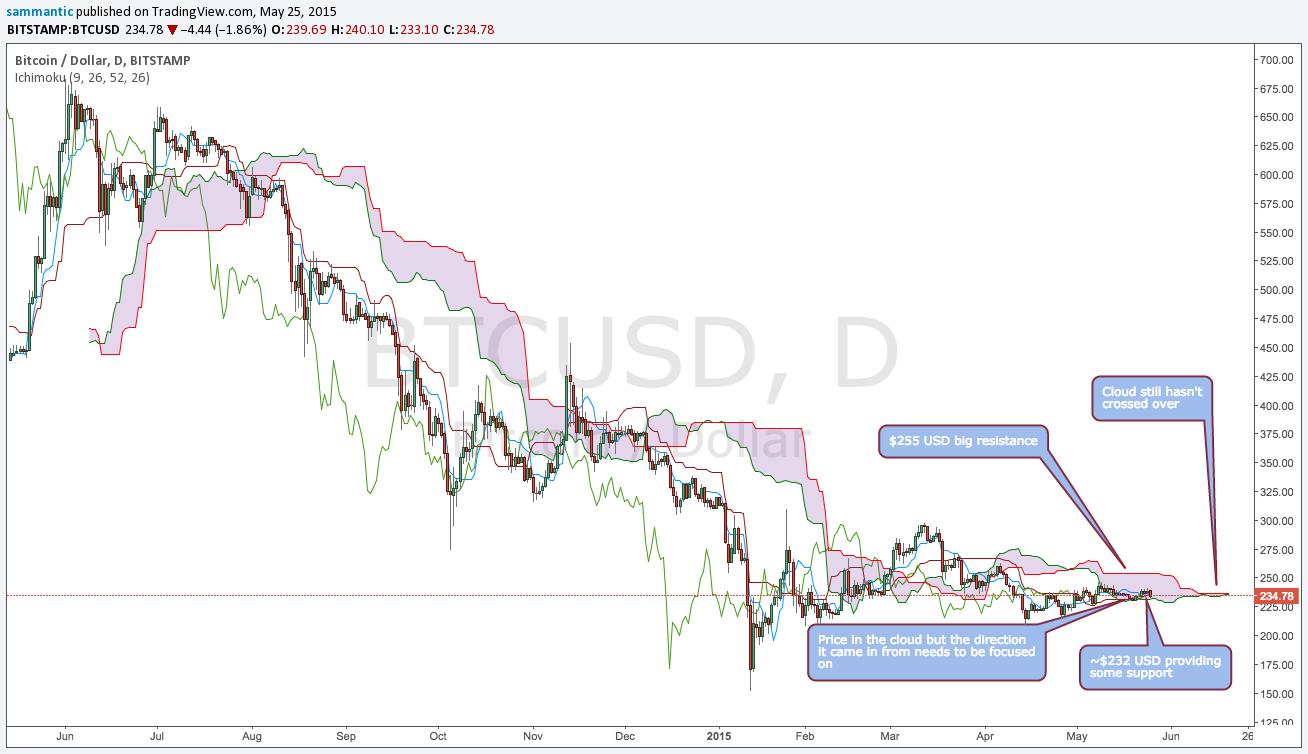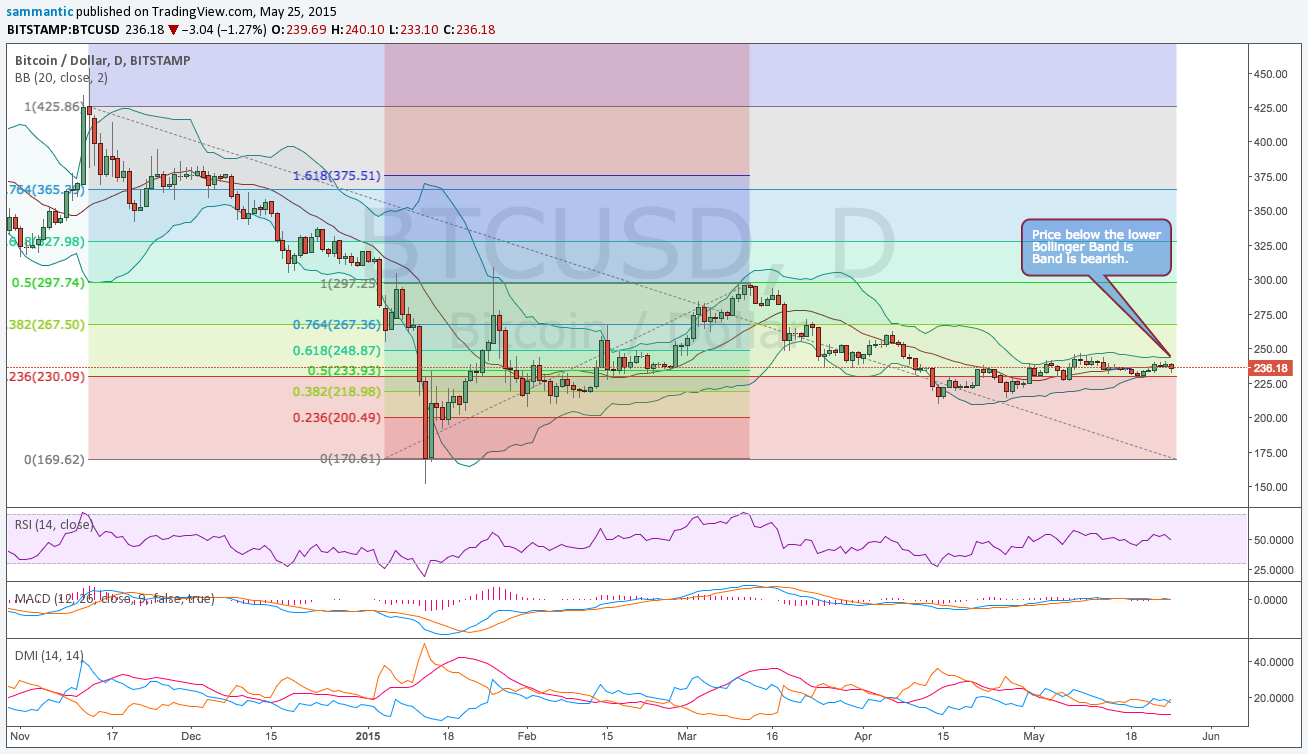For timely updates on price updates, follow me @sammantic
Price at the time this article was written is: US$237.44
Last week, the article began with:
“The good news continues to be discounted, which generally isn’t indicative of a move higher. On the other hand, there’s an old adage which applies here: ‘Never short a dull market.’”
Resolution of this range should come soon and it could be a big move since there has been less and less on-exchange liquidity in recent months.
Technically we are pretty much in the same place with perhaps a more bearish leaning slant since price is having so much difficulty staying above its 50 day EMA. As has been mentioned in previous articles, “the slope of all the EMAs (50, 100, and 200) is sloping downward, however they are sloping less so. The 50 and 100 day EMA’s are starting to tighten as well. This all is setting up for a move.”
The 50 day EMA (~US$238 USD) is still proving to be a major nuisance, the price has not been able to stay above it for a very long time now and this can only be construed as bearish. A significant price move is still expected, however, as all the indicators continue pointing towards this happening.
Long-Term
The 1-year chart (long-term) for bitcoin remains bearish. The price remains below all 3 of its EMAs. The 50 day EMA is still proving to be a major resistance area at approximately ~US$238. Price has been rejecting higher levels for well over a month.
All 3 EMAs continue to tighten. They all continue to move closer to each other and price is looking likely to move. As the 50 and 100 day moving averages continue to compress with the price underneath, a downside move looks more likely than an upside move.
Bollinger Bands have also been added and are super tight at the moment. In fact they haven’t been this tight in the entire 1-year chart. This happens when volatility declines as it has in the bitcoin price. The tightening indicates that a significant price move is coming. Think of the Bollinger Bands like a rubber band that is getting stretched out and what happens when you stretch a rubber band as far as it will go and then release it. It snaps aggressively and this is what should happen in the price.
The Relative Strength Index (RSI) looks to have put in a quadruple top and has not had the strength to move to higher levels, and is now starting to turn downwards. This suggests the possibility of a downwards price move. Also note that the MACD is sitting on the zero line and has essentially remained flat for an extended period. All of this has happened on very low volume. These are not signs of a trend change. Instead, MACD is showing that there is no momentum for an up move.
On Balance Volume (OBV) has been added as well and has been flat for months. This indicator has been added to see if it may be time to get bullish. The theory behind OBV is that volume precedes price and if there is going to be a big move up or reversal in price it would be seen in volume. Clearly that is not the case here based on the chart. It seems to be signaling that a downward continuation in price is possible.

Ichimoku Clouds
The 1-year Ichimoku (cloud chart) essentially remains the same. Price has entered the bottom of the cloud and continues to stay near the lower bound of the cloud. ~US$232 is now providing some support for the price as it is the lower bound of the cloud.
When looking at the clouds, it’s important to remember which direction price enters the cloud from. Since it entered from below, the cloud should continue to be resistance for the price and the ~US$255 (which is the top of the cloud) will be a major test if price ever gets there.
The cloud ahead has attempted a bullish crossover twice with no success. This continues to be bearish for future price and is something to continue watching out for.
The Chikou Span (Lagging Line) is below the cloud, along with the Tankan Sen (Conversion Line) and the Kijun Sen (Base Line). The Tankan Sen and the Kijun Sen have pierced the cloud but are also dragging down near the lower bounds. Momentum appears to be waning at the lower bound of the cloud and price needs to hold in the above mentioned support area.
The price is spending a lot of time not getting anywhere. It’s starting to look like it’s going to be difficult for the price to stay above the lower bound of the cloud. For further definitions of what is being discussed, please refer to this previous post on Ichimoku cloud charts.

Intermediate-Term Trend
Using Fibonacci retracements from an intermediate-term price high of US$427 recorded back in mid-November, we see that the price is above the support at ~US$230. Another Fibonacci Retracement was run from the mid-March highs to look for additional support and resistance areas. ~$233 USD and ~$230USD are the next support areas, with ~$230 USD being a big one as it confirms the lower bound of the Ichimoku cloud. That makes it an important area to hold.
A test of US$230 looks likely since price has not been able to get above the 50-day EMA and momentum continues to wane. If it falls below this level, there are some minor support levels (like ~$220 USD) below but the US$210-215 looks like it will provide major support.
The RSI and MACD are both flat and appear to be topping out. This continues to show that momentum is stalling.
Included is the Directional Movement Index (DMI), which looks at buying and selling pressures. The blue line indicates buying pressure, the red line indicates selling pressure and the orange line is the ADX, which indicates the strength or weakness of a trend.
Buying Pressure and Selling Pressure continue to fall and are both below the ADX. This is yet another sign that momentum has topped out and price is range bound on very small volume. This is happening at low levels, which means volume and momentum are not confirming the higher move that occurred to the top of the price range. This again confirms that price is getting ready to make a move one way or the other. The ADX has crossed over the Buying Pressure Line, which could initiate a sell signal because this means buying pressure has declined and the sellers might start to attack.
The Bollinger bands in the intermediate time frame are even tighter and the price has just fallen out of the lower Bollinger Band. This should mean more weakness in price and perhaps a bigger move may accelerate.

Short-Term Trend
Looking at the short-term trend (May 24 price high of ~US$240) using Fibonacci retracements, a big base has formed at the US$235 level and is now providing support. If this breaks, a test of the ~$230 USD level should happen in short order. This area is becoming more and more important. Short term, US$235 and US$231 are really big areas. If these should break down, the US$225 and US$221 come into play, but will probably be stops on the way to testing the ~US$210 level. The RSI and Money Flow are both heading down confirming the price. The MACD has triggered a short term sell signal as well.

Big move imminent
Bitcoin is still in a primary downtrend and with all the tension in the moving averages and Bollinger Bands, a big move is still what is being looked for.
The price needs to hold above US$235 and US$230. Momentum and volume continue to be at low levels. The 50-day EMA continues to provide very big resistance as price has continuously failed to stay above this mark.
The price action has been as fun as watching paint dry so staying cautious and patient is still the way forward. Every rally in price in recent months has been at lower levels and this latest one demonstrates that point. A retest of the ~US$210 area continues to look like a possibility.
Disclaimer: Articles regarding the potential movement in crypto-currency prices are not to be treated as trading advice. Neither Cointelegraph nor the Author assumes responsibility for any trade losses as the final decision on trade execution lies with the reader. Always remember that only those in possession of the private keys are in control of the money.
